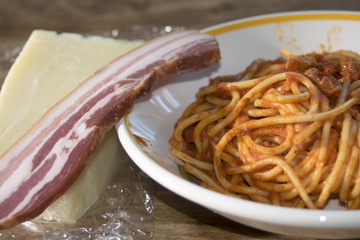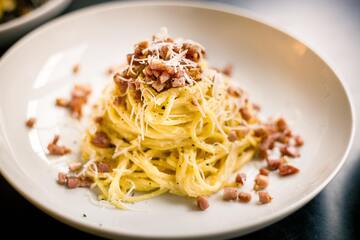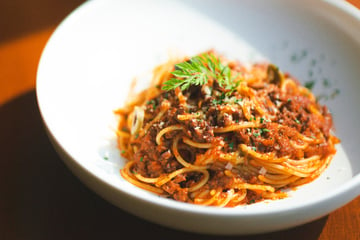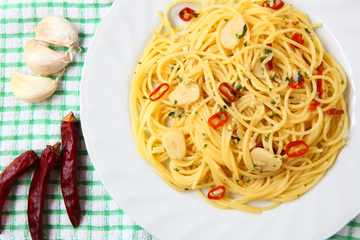How to make homemade ravioli: An easy recipe
With a good bite and a little pocket of goodness in the center, ravioli is a versatile and endlessly delicious meal. What if we told you, though, that making homemade ravioli is not actually all that hard?
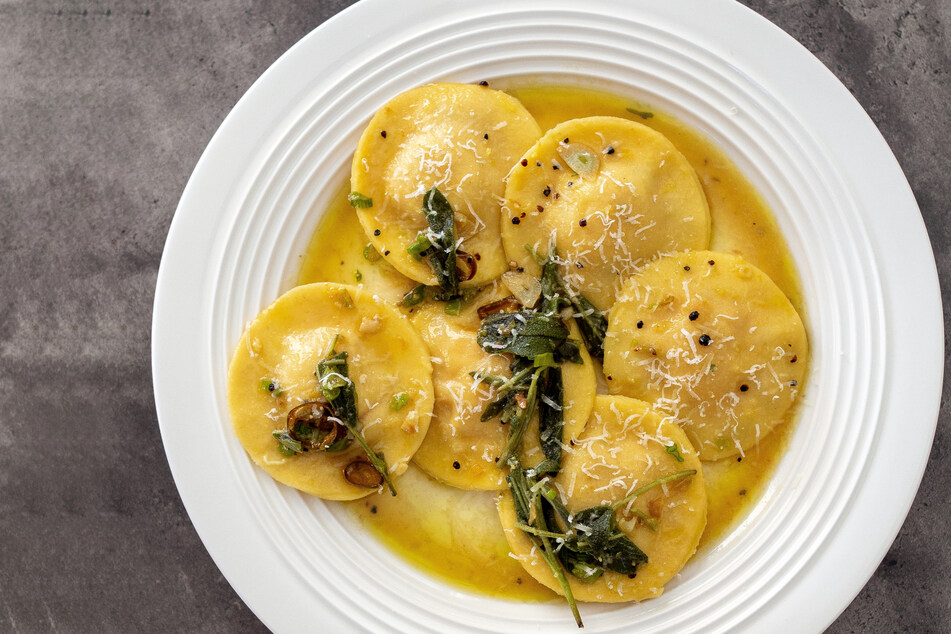
With a vast variety of fillings available, ravioli is one of those Italian foods often overlooked in the home cooking scene.
Most will head-on-down to the supermarket, buy a bag of frozen and relatively tasteless ravioli, and chuck them in a rich sauce that drowns out the actual pasta. It's a shame, as there's another way, and it's truly wonderful!
If you're a fan of Italian food, it's time to start making things from scratch. Put away the frozen ravioli, toss the supermarket pasta, and get your hands dirty with our homemade ravioli recipe.
It's easier than you might think.
What is ravioli, and what is the history of ravioli?
Ravioli is a pouch of pasta that contains some kind of filling enveloped within it. It is a staple of not only Italian food and your average home kitchen, but fine dining as well, and tradition. They often come in a square shape which bulges in the center, but are sometimes formed in a circle or half circle shape.
It is believed that ravioli first appeared in Venice during the 14th century. They were typically filled with green herbs and minced meat, though sometimes were filled or served with seafood of one kind or another. Since then, they have migrated south, and have even become a staple of Roman cuisine.
If you're interested: Many other countries have their own version of ravioli, or at least something similar. Some examples include Jewish kreplach, Japanese gyoza, various Asian dumplings, German maultaschen, Indian gujiya, and even Middle Eastern shishbarak. This is but a short list, with many other similar dishes around the world.
How to make ravioli from scratch: Recipe
Ravioli isn't too complicated or difficult. At its very basic level, it's simply a dough made out of flour, salt, and egg yolk. The complexity comes in its shape, the process of kneading, and the way that you incorporate filling and sauce. In terms of materials and equipment, ravioli is so simple that you don't even really need a pasta maker.
Here's what you'll need to make homemade ravioli:
- A pasta maker or a wooden rolling pin
- Ravioli cutter or a butter knife
- Pot
- Measuring cups
- Wooden spoon
- A flat surface
- Whatever you need for the filling and/or sauce
Important: We will provide a brief and simple run-down of what you need to do to make the pasta dough. If you need more information, check out our extensive guide to making homemade pasta.
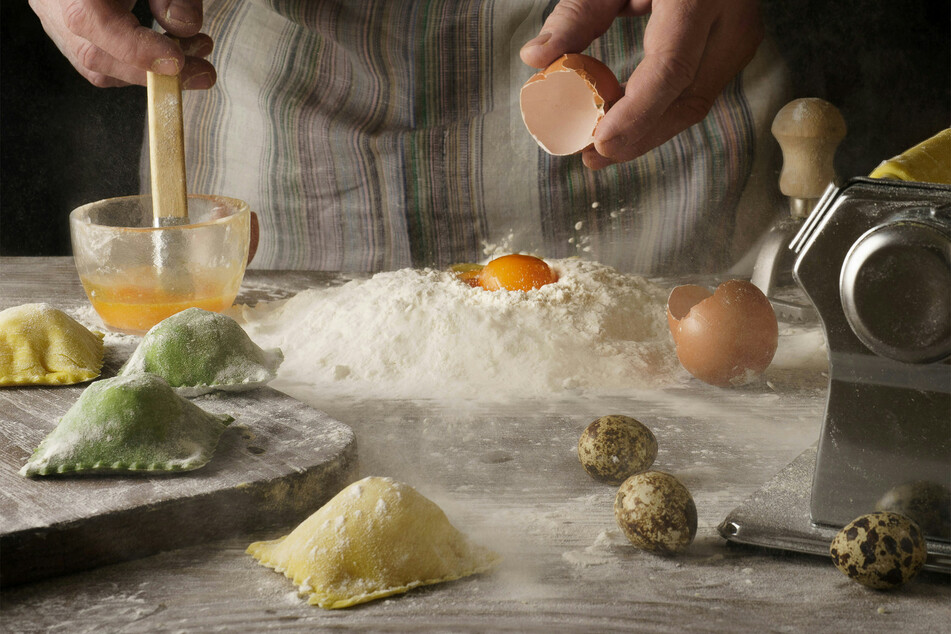
Homemade ravioli recipe | Ingredients
We are not going to go too deep into the process of making an entire ravioli dish in this recipe. This is simply a breakdown of how to make the ravioli themselves, followed by a few suggestions for fillings and toppings. Ultimately, it's about getting the right texture in the pasta, and shaping it so that water doesn't get in when you boil and cook your ravioli.
Here are the ingredients you will need to make ravioli:
- At least 3 eggs
- At least 10 oz flour
- Pinch of salt
- Filling
On the proportions: The general rule is that you should have about 3.5 ounces of flour per egg, with the minimum amount of flour being 6 ounces with 2 eggs. If you need to make more ravioli, adjust your quantities proportionately.
Homemade ravioli recipe | Instructions
Making ravioli is not a hard process, but it can be a very fiddly one that'll take time and patience to do properly. You need to be careful, with the most important thing being to get the right thickness on the pasta itself, and to seal the edges of the pouch so that nothing can get in or out during the cooking process.
Here's how to make homemade ravioli:
Step 1: Start by measuring out your ingredients, making sure that you have the right amount for the quantity of pasta you need.
Step 2: Mix the salt into the flour, and then form the flour into a volcano shape on the top of your kitchen counter. Separate your eggs, setting aside your whites for another recipe.
Step 3: Add your egg yolks to the center of your flour volcano and slowly but surely fold in the sides of the volcano. Do this by, having whisked the yolks with your finger, making a circular motion that slowly collapses the inside of the flour's crater.
Step 4: As you mix, continue to integrate the egg with the flour until it is totally combined and there is no dry flour or runny egg.
Step 5: Begin kneading your dough, using the standard fold and turn method we described in our homemade pasta recipe and homemade pizza dough recipe.
Step 6: As you knead the pasta, dust the surface of the counter with more flour. Continue until your dough is dry and smooth.
Step 7: Cover and let it rest for at least 2–3 hours.
Step 8: Separate your dough into manageable clumps, ready to be flattened and stretched into ravioli.
Step 9: With each individual bit of pasta, stretch it out using the widest setting on your pasta maker, or a rolling pin. You want it to be a rectangle shape and about a quarter of an inch thick.
Step 10: Once stretched out, fold it in half again and repeat the process. Do this at least 5 times to layer your pasta and add texture.
Step 11: Cut into strips about 2 inches wide, or wider if you are making bigger ravioli.
Step 12: Add your filling to one side of the pasta, in little blotches one-to-two inches apart along the length of your dough. Make sure that they are well spaced apart and that there is at least an inch of pasta free above them.
Step 13: Fold over the pasta and, using your fingers, press down on the pasta to seal the pouches. Use a ravioli cutter or a knife to cut each individual ravioli out.
Step 14: Use a fork or the ravioli cutter to press in and seal the sides of the ravioli, so no water can get in, and no filling can get out.
Step 15: Boil for five minutes at a rolling boil in seasoned water. Alternatively, store in the freezer or (for shorter periods) fridge. Make sure that stored ravioli is dusted with flour to keep them from sticking together.
So there you have it. While it takes a good long while to shape and form each ravioli, it is worth the time and effort and can be good fun for the whole family.
Best ravioli fillings
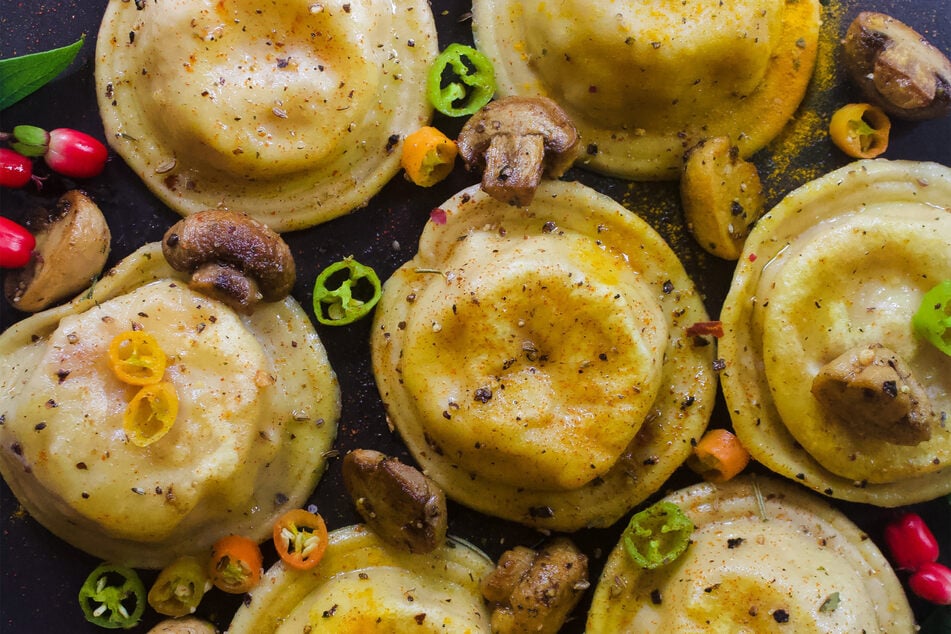
When it comes to filling, there are so many options that we could hardly list them all. Instead, here are a few simple suggestions, including rough ingredients.
Our emphasis is on flavor and texture, so feel free to come up with your own alternatives and experiment a little bit.
Here are our favorite ravioli fillings:
- Pumpkin and feta: Roasted or boiled pumpkin seasoned with salt, pepper, and mixed with feta or another cheese.
- Spinach and spice: Spinach pan fried with red onions and spices (garam masala, cumin, black pepper, cardamom) and blitzed in the blender.
- Ricotta and prosciutto: Ricotta cheese mixed with diced prosciutto and pecorino romano.
- Parsley and ricotta: Parsley mixed with well-seasoned ricotta cheese and pecorino romano.
- Beef and butter: Butter fried ground beef with garlic, blended spinach and parsley, and parmigiano reggiano.
Try out a few of these fillings and experiment as much as you like. It's all about making a hearty and delicious meal that'll please everyone involved.
Best ravioli sauces
In our opinion, the best ravioli sauces are light and simple, to allow your homemade pasta and the filling to shine through and be the real star of the dish. Still, there's no reason not to experiment a little bit with this one too, or to try out a few classics along the way.
Here are our favorite ravioli sauces:
- The basic tomato sauce: Your standard tomato base, with blended tomato, salt and pepper, garlic, and olive oil. Sprinkled with parmigiano reggiano.
- Browned butter: Simple browned butter, topped with either parmigiano reggiano or pecorino romano.
- Lemon and basil: Make a simple lemon sauce, infused with basil, thicken with some cheese (parmigiano or pecorino) and seasoned pasta water.
- Mushroom: Butter sautéd mushrooms creamed up with a dash of pasta water and a bit of pecorino romano.
It's not hard to make a simple butter or olive oil sauce, and to be honest, that's probably your best bet. Make the cheese, pasta, and filling sing, and complement it with a bit of sweet fattiness that'll make your pallet throb and your heart pound.
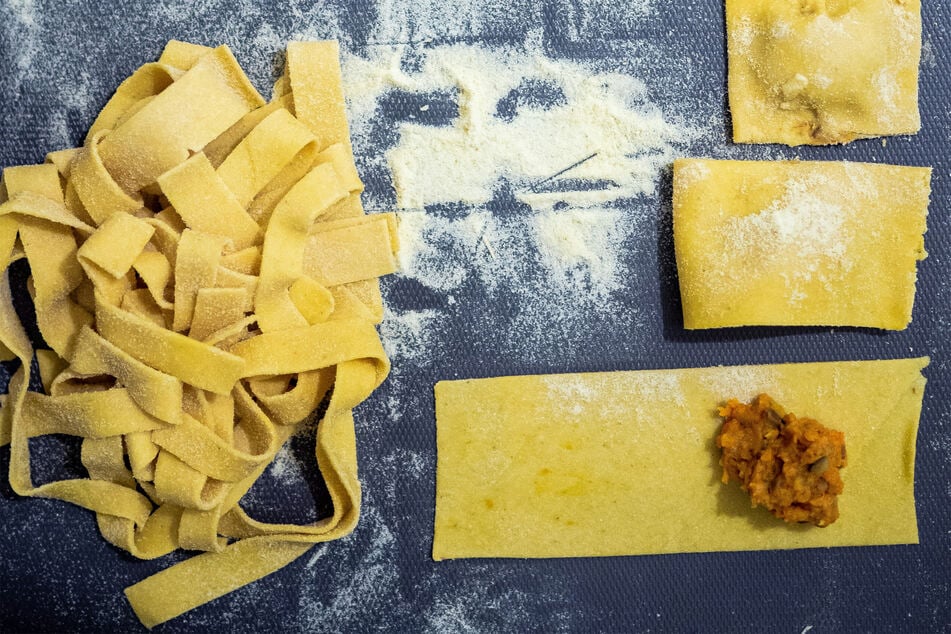
Homemade ravioli isn't too hard
The only drawback to making your own ravioli is the time that it takes. It isn't the difficulty, it isn't flavor, it isn't the texture, and it most certainly isn't the experience. Time is the only thing that makes it difficult to turn your ravioli-making into a sustained habit.
Yet, time can also be an asset. Sit down with the family or friends and do it together, listen to some good music, put on your favorite radio show. Homemade ravioli is delicious, easy, and communal, and you won't regret giving it a fair shake of the sauce bottle.
Cover photo: Unsplash/Yoav Aziz

